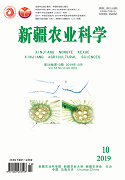|
|
Effect of Shading on the Photosynthetic Characteristics and Yield in Winter Wheat in Southern Xinjiang
ZHANG Hong-zhi, Aizizi Julaiti, CUI Yue, ZHAO QI, KONG De-peng, HU Ai-zhi,WANG Li-hong, WANG Zhong, ZHANG Yue-qiang, FAN Zhe-ru, LI Jian-feng
2019, 56(10):
1765-1771.
DOI: 10.6048/j.issn.1001-4330.2019.10.001
【Objective】 To study the effects of different shading treatments on photosynthetic characteristics and yield of winter wheat in the hope of providing theoretical basis for high yield cultivation and management of wheat under fruit tree and wheat intercropping model in southern Xinjiang by using artificial shade simulation of three kinds of fruit trees (walnut, apricot and jujube) under the condition of the middle and later periods of the wheat growth in different degree of shade. 【Method】 The winter wheat variety tested was Xindong 20, and four treatments were set in the shading treatment: S1: shading at the pulling-heading stage was 10%- 25%, S2: shading at the pulling-heading stage was 20%-50%, S3: shading at the pulling-heading stage was 30%- 75% and S0: not shading at the pulling stage. Shading was from the jointing stage to maturity stage and the effects of shading on photosynthesis, dry matter accumulation, distribution and yield of wheat were studied. 【Result】 The photosynthetic rate of wheat flag leaf decreased significantly with the increase of shade during blooming period. There was no significant difference between mild shade Pn in grouting period and control period, but it was significantly higher than those of S2 and S3 treatment. Both Tr and Gs decreased with the increase of shading amplitude, and Ci increased with the increase of shading amplitude. With the increase of shading amplitude, the amount of total dry matter accumulation and the distribution to seeds all showed a decreasing trend, the distribution of dry matter to grain decreased by 9.5%, 24.2% and 27.7% respectively. The number of ears harvested, 1,000-grain weight, yield and economic coefficient all decreased significantly with the increase of shading amplitude, while the effect of light shading on panicle number was not obvious. The yield and economic coefficient decreased by 22%, 42.9%, 67.8% and 8.9%, 23.8% and 27.6%, respectively with the increase of shading amplitude. 【Conclusion】 With the increase of shading amplitude, Pn, Tr and Gs of wheat were decreased, intracellular CO2 concentration increased, total dry matter accumulation and distribution ratio to grain decreased, panicle number and 1,000-grain weight decreased, moderate and severe shading yield decreased significantly, resulting in a significant decrease in yield and economic coefficient.
|

